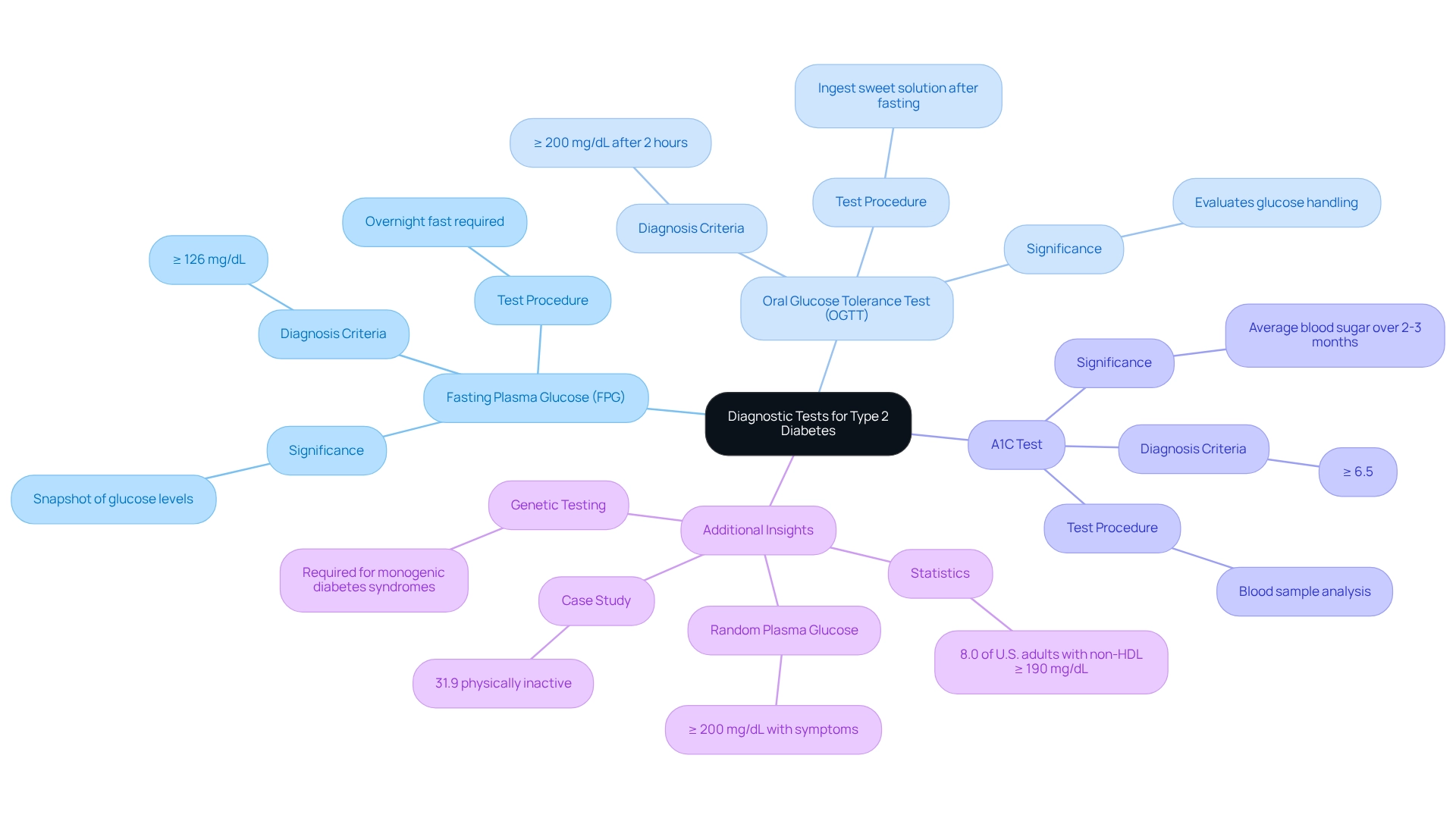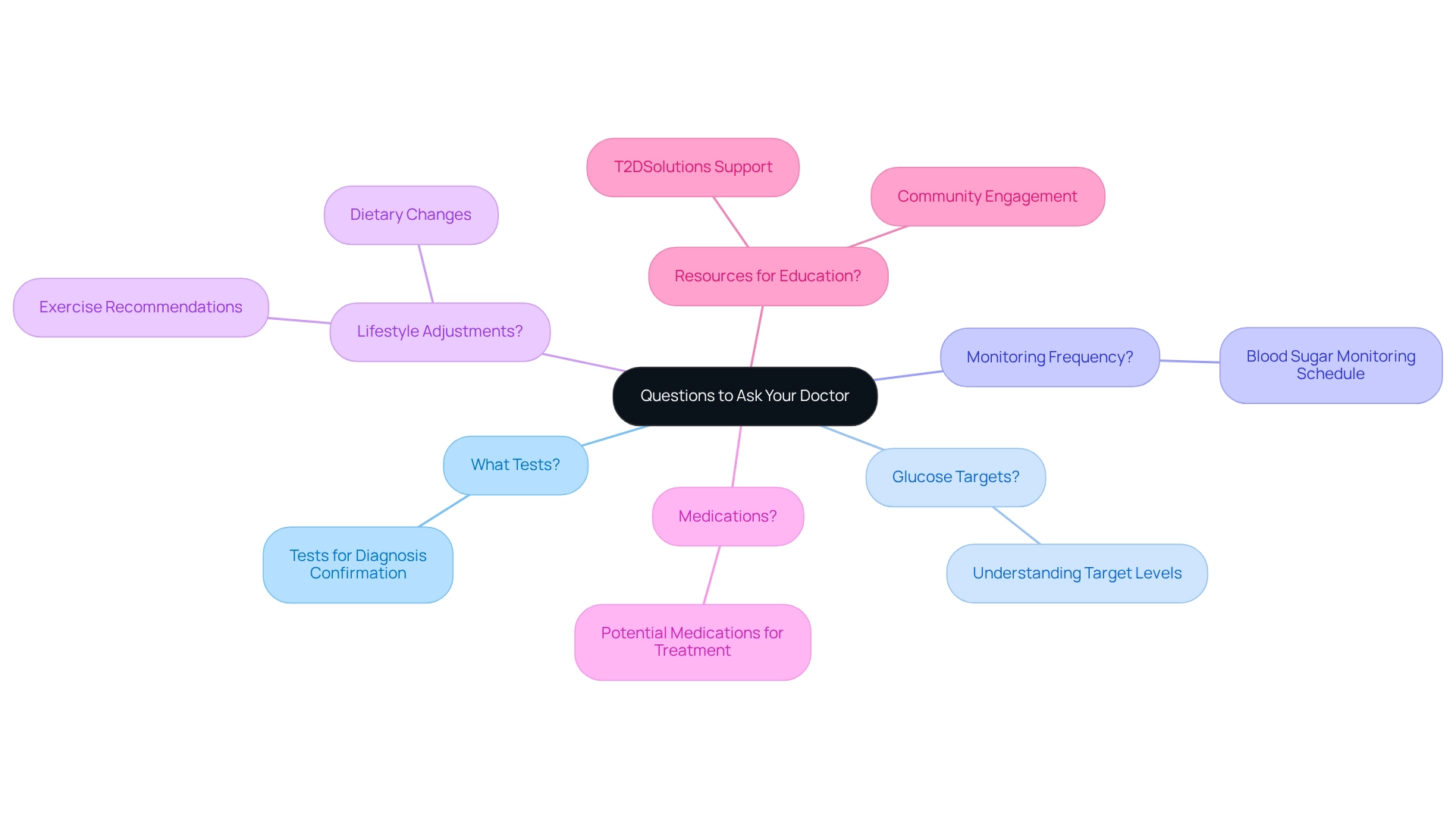Overview
If you suspect you might have Type 2 Diabetes, it's important to know that getting diagnosed typically involves several key tests. These include the Fasting Plasma Glucose (FPG), Oral Glucose Tolerance Test (OGTT), and A1C testing. Each of these tests plays a vital role in measuring blood sugar levels and assessing insulin resistance.
Recognizing the significance of these tests is essential, as they can help identify the condition early. It's understandable to feel overwhelmed by this process, but early diagnosis and proactive management can significantly reduce the risk of complications associated with diabetes. Remember, you’re not alone in this journey. Seeking support and understanding your options can empower you to take control of your health.
We encourage you to reach out for resources or connect with others who may be experiencing similar challenges. Sharing your experiences can foster a sense of community and support, reminding you that there are people who care and want to help you through this.
Introduction
Type 2 Diabetes is more than just a medical condition; it represents a complex interplay of biology, lifestyle, and personal health. As the prevalence of this chronic disease continues to rise globally, it's understandable to feel overwhelmed.
Understanding its fundamental concepts becomes essential for effective management and prevention. This article delves into the key terminology surrounding Type 2 Diabetes, the diagnostic tests that can reveal its presence, and the symptoms that warrant attention. It also emphasizes the importance of preparation for medical appointments, equipping you with the knowledge to engage actively in your health journey.
By exploring these aspects, you can gain valuable insights into navigating your diagnosis and fostering a proactive approach to your well-being. Remember, you are not alone in this journey; we are here to support you every step of the way.
Understand Type 2 Diabetes: Key Concepts and Terminology
Type 2 Diabetes is a long-term condition that many face, characterized by insulin resistance. This means that the body struggles to use insulin effectively, resulting in increased glucose levels. Understanding some key terms can help you navigate your diagnosis and treatment with confidence:
- Insulin: This vital hormone regulates glucose levels, enabling cells to absorb energy from this substance.
- Hyperglycemia: Elevated glucose levels define this condition and can lead to serious health complications if not managed properly.
- Insulin Resistance: Here, the body's cells become less responsive to insulin, making it challenging for glucose to enter the cells, which raises glucose levels.
- Prediabetes: This state serves as a precursor to Type 2 Diabetes, marked by glucose levels that are higher than normal but not yet high enough for a diagnosis.
Becoming familiar with these terms is essential, as they form the foundation for understanding your condition and exploring effective management strategies. It's understandable to feel overwhelmed, but you're not alone in this journey. Recent statistics indicate a significant rise in diabetes prevalence, with the World Health Organization emphasizing the urgent need for effective control strategies to address disparities in diabetes risk factors and burden. By grasping these concepts, you empower yourself to engage actively in your health journey, knowing that support is available every step of the way.

Explore Diagnostic Tests: FPG, OGTT, and More
Several tests are essential for diagnosing Type 2 Diabetes, each offering unique insights into blood sugar levels that can help you understand your health better:
-
Fasting Plasma Glucose (FPG): This test assesses blood sugar concentrations following an overnight fast. If your result is 126 mg/dL or higher, it may indicate diabetes. The FPG test is significant as it provides a clear snapshot of glucose levels when your body is not influenced by recent food intake.
-
Oral Glucose Tolerance Test (OGTT): After an overnight fast, you’ll ingest a sweet solution, and your blood glucose will be measured at intervals. A reading of 200 mg/dL or higher two hours after ingestion confirms diabetes. This test is especially beneficial for evaluating how your body handles glucose over time, indicating its capacity to manage carbohydrate intake effectively.
-
A1C Test: This blood test assesses your average blood sugar levels over the past two to three months. An A1C of 6.5% or greater verifies the condition. This test is valuable for understanding long-term glucose control and can help guide your treatment decisions.
Additionally, random plasma glucose readings of 200 mg/dL or greater, combined with typical signs of hyperglycemia, can also suggest the condition. Recent statistics indicate that 8.0% of U.S. adults diagnosed with the condition had a non-HDL level of 190 mg/dL or higher, highlighting the importance of comprehensive testing in managing diabetes.
Healthcare professionals emphasize the importance of the OGTT in diagnosing the condition, as it can uncover glucose intolerance that may not be evident through other tests. As noted by the American Diabetes Association, "With your support, the American Diabetes Association® can continue our lifesaving work to make breakthroughs in research and provide individuals with the resources they need to combat this condition."
Real-life examples demonstrate the effectiveness of these tests; for instance, a case study revealed that 31.9% of adults with blood sugar issues were physically inactive. This highlights the necessity for regular monitoring and lifestyle adjustments. Understanding these tests will empower you to engage in informed discussions with your healthcare provider about how do you get diagnosed with type 2 diabetes and how to manage it. Remember, you're not alone in this journey; we are here to support you every step of the way.

Identify Symptoms: Recognizing the Signs of Type 2 Diabetes
Common symptoms of Type 2 Diabetes that you might notice include:
- Increased Thirst: A persistent feeling of thirst that remains even after drinking.
- Frequent Urination: An increased need to urinate, particularly during the night.
- Extreme Hunger: Intense feelings of hunger that occur even after meals.
- Fatigue: Unusual tiredness or a lack of energy that is not typical for you.
- Blurred Vision: Difficulty in seeing clearly, which can fluctuate.
- Slow Healing Sores: Cuts and bruises that heal more slowly than expected.
Recognizing these symptoms is crucial. It’s understandable to feel concerned, especially considering that 22% of individuals aged 70 or older are diagnosed with Type 2 Diabetes. This statistic highlights the importance of awareness among older adults, who may be at higher risk. Additionally, the typical medical costs for individuals diagnosed with this condition are 2.6 times greater than for those who do not have it. This emphasizes the financial consequences of late diagnosis and the need for prompt intervention.
If you experience any of these symptoms, please consult a healthcare provider to understand how do you get diagnosed with type 2 diabetes through a thorough evaluation. Early recognition and proactive management can significantly reduce the risk of complications associated with diabetes. Remember, you're not alone in this journey. T2DSolutions is here to support you in managing your symptoms and connecting you with resources that can help. As specialists often say, "Exercise is essential in losing and managing weight and reducing cholesterol and arterial pressure." This underscores the significance of lifestyle adjustments.
Discussing symptoms with healthcare professionals can clarify how do you get diagnosed with type 2 diabetes, leading to timely interventions and better health outcomes. Case studies have shown that individuals who adopted lifestyle changes—such as weight loss and increased physical activity—successfully lowered their risk of developing Type 2 Diabetes. We are here to support you every step of the way.

Prepare for Your Appointment: Questions to Ask Your Doctor
To maximize the effectiveness of your appointment, it's essential to come prepared with questions for your doctor. This preparation not only empowers you but also fosters a more effective dialogue with your healthcare provider. Consider asking the following questions to better understand how do you get diagnosed with type 2 diabetes:
- What tests will I need to confirm my diagnosis?
- What are my glucose targets?
- How often should I monitor my blood sugar levels?
- What lifestyle adjustments should I contemplate to manage my condition effectively?
- Are there any medications I should be aware of that could assist in my treatment?
- What resources are available for education and support regarding blood sugar management, including those provided by T2DSolutions?
Research indicates that patients who prepare questions in advance are more likely to leave their appointments with a comprehensive understanding of their diagnosis and the necessary next steps. It's understandable to feel overwhelmed, but participating in open dialogue can significantly improve your management journey. T2DSolutions offers valuable resources and community support that can assist you in managing your condition effectively. For instance, community support has proven to be vital in fostering resilience among individuals managing diabetes, as shared experiences can lead to better outcomes. By asking these questions, you not only empower yourself but also contribute to a more effective patient-doctor dialogue. Remember, you're not alone in this journey; we are here to support you every step of the way.

Conclusion
Understanding Type 2 Diabetes is crucial for effective management and prevention. This article has explored key concepts such as insulin, hyperglycemia, insulin resistance, and prediabetes, which form the foundation for navigating the complexities of this chronic condition. By becoming familiar with these terms, you can better understand your diagnosis and the necessary steps for treatment.
In addition to terminology, the importance of diagnostic tests like the Fasting Plasma Glucose, Oral Glucose Tolerance Test, and A1C test has been highlighted. Each of these tests provides unique insights into blood sugar levels, enabling healthcare providers to make informed decisions about your care. Recognizing the symptoms of Type 2 Diabetes—such as increased thirst, frequent urination, and fatigue—can lead to timely interventions and better health outcomes.
Preparation for medical appointments is another vital aspect discussed. By formulating questions in advance, you can engage more effectively with your healthcare providers, ensuring a comprehensive understanding of your condition and the steps needed to manage it. This proactive approach not only empowers you but also fosters a collaborative relationship between you and your doctors.
Ultimately, navigating Type 2 Diabetes requires a multifaceted approach that combines knowledge, awareness, and open communication. With the right tools and support, you can take charge of your health journey, significantly improving your quality of life and reducing the risk of complications. Remember, you are not alone in this journey; resources and community support are available to assist you every step of the way.
Frequently Asked Questions
What is Type 2 Diabetes?
Type 2 Diabetes is a long-term condition characterized by insulin resistance, meaning the body struggles to use insulin effectively, leading to increased glucose levels.
What is insulin and its role in the body?
Insulin is a vital hormone that regulates glucose levels, enabling cells to absorb energy from glucose.
What does hyperglycemia mean?
Hyperglycemia refers to elevated glucose levels in the blood, which can lead to serious health complications if not managed properly.
What is insulin resistance?
Insulin resistance is a condition where the body's cells become less responsive to insulin, making it difficult for glucose to enter the cells, which raises glucose levels.
What is prediabetes?
Prediabetes is a state that serves as a precursor to Type 2 Diabetes, characterized by glucose levels that are higher than normal but not yet high enough for a diabetes diagnosis.
Why is it important to understand these terms related to Type 2 Diabetes?
Understanding these terms is essential as they form the foundation for comprehending the condition and exploring effective management strategies.
What does the rise in diabetes prevalence indicate?
The rise in diabetes prevalence indicates an urgent need for effective control strategies to address disparities in diabetes risk factors and burden, as emphasized by the World Health Organization.



